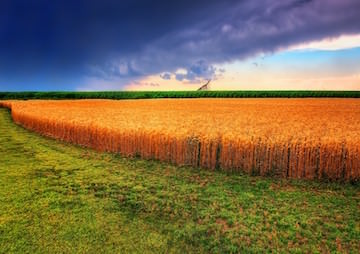Scientists Calculate Our Debt to Earth
Researchers in the U.S. have found a way to put a monetary value on the multitude of vital services and assets we rely on nature to provide us cost-free.
By Tim Radford / Climate News Network

Wheat crops in Kansas depend on aquifer water. (James Watkins via Flickr)
This Creative Commons-piece first appeared at Climate News Network.
LONDON — Perhaps for the first time, scientists have put a direct cash value on the metaphor that conservationists call “natural capital”.
This is, in effect, the money humans don’t have to spend on services that nature supplies for free — such as crop pollination, water purification, and coastal protection by wetlands, sandbanks and reefs.
And one high value transaction supplied gratis by nature is groundwater. For farmers, water in subterranean aquifers represents money in the bank, as groundwater underwrites 40% of world food production.
Eli Fenichel, assistant professor at the Yale School of Forestry and Environmental Studies, and colleagues looked at withdrawals from the Kansas High Plains Aquifer and report in the Proceedings of the National Academy of Sciences that between 1996 and 2005, Kansas lost approximately $110 million a year.
Food production
The losses represented the depletion of the aquifer as farmers withdraw this ultimate natural capital to support food production. And the total for the decade was $1.1 billion.
This is roughly equal to Kansas State’s 2005 budget surplus. It is, the scientists say, substantially more than the sums invested in schools over the same period.
It isn’t often that economists can place any direct value on a natural resource. Farming and industry evolved as they did because the natural resources were there in the first place.
Conservationists sometimes pose the question: if plants had not evolved alkaloids that could be exploited as pharmaceutical drugs, or if there were no bees to pollinate fruit blossom, what would humans have to pay to get someone else to do these things?
And if forests failed to absorb humans’ carbon emissions from fossil fuel combustion and greenhouse gas release, how bad could global warming get?
But such questions are rhetorical, part of persuasive argument for conserving forests or using pesticides sparingly.
“Our work can help
governments and businesses
track the sustainable use of natural resources”
City planners, geophysicists and climate scientists alike call reefs natural capital because living reefs help protect maritime cities from the worst storm surges, and they try to arrive at a value based on the cost of storm damage to those cities. That, too, is a complicated argument.
But the latest study delivers a relatively sure balance sheet of costs and rewards, profits and losses.
The scientists used economic principles to value traditional assets, and then factored in ecosystem changes and human behaviour that might make such assets increase or reduce in value. This could help governments and business redefine spending on nature conservation as investment.
“The idea that we can actually measure changes in the value of natural capital is really important,” Dr Fenichel says. “It shows that in places like Kansas, where groundwater is a critically important asset, there is a way to measure and keep tabs on these resources as part of a larger portfolio.
“And in a world where data is more and more available, it should be possible to do this more often. I think that bodes well for guiding policies aimed at maintaining all of society’s wealth.”
For a business to be sustainable, its reserve capital must not decline with time. The new approach means that the natural capital represented by groundwater can be turned into a set of figures on a balance sheet.
Asset management
Its steady, year-on-year depletion doesn’t look like good asset management. And it doesn’t look sustainable. But the Kansas study could help as a template for other such valuations.
“Without an apples-to-apples valuation approach, the value of natural capital cannot be measured against other assets and expenses,” says Joshua Abbott, associate professor at Arizona State University’s School of Sustainability, and one of the authors of the report.
“Our work can help governments and businesses track the sustainable use of natural resources. Without a calculation like ours, policymakers would lack critical information about how food production impacts our water wealth.”
And Dr Fenichel adds: “I’m not saying it will be easy, or that we are going to measure natural capital prices for everything, everywhere in the world. But I think we are showing that it is feasible.
“I think we are laying the foundations for others to go out, collect data, and do the calculations to measure wealth stored in other natural capital assets.”
Tim Radford, a founding editor of Climate News Network, worked for The Guardian for 32 years, for most of that time as science editor. He has been covering climate change since 1988.
Your support matters…Independent journalism is under threat and overshadowed by heavily funded mainstream media.
You can help level the playing field. Become a member.
Your tax-deductible contribution keeps us digging beneath the headlines to give you thought-provoking, investigative reporting and analysis that unearths what's really happening- without compromise.
Give today to support our courageous, independent journalists.






You need to be a supporter to comment.
There are currently no responses to this article.
Be the first to respond.